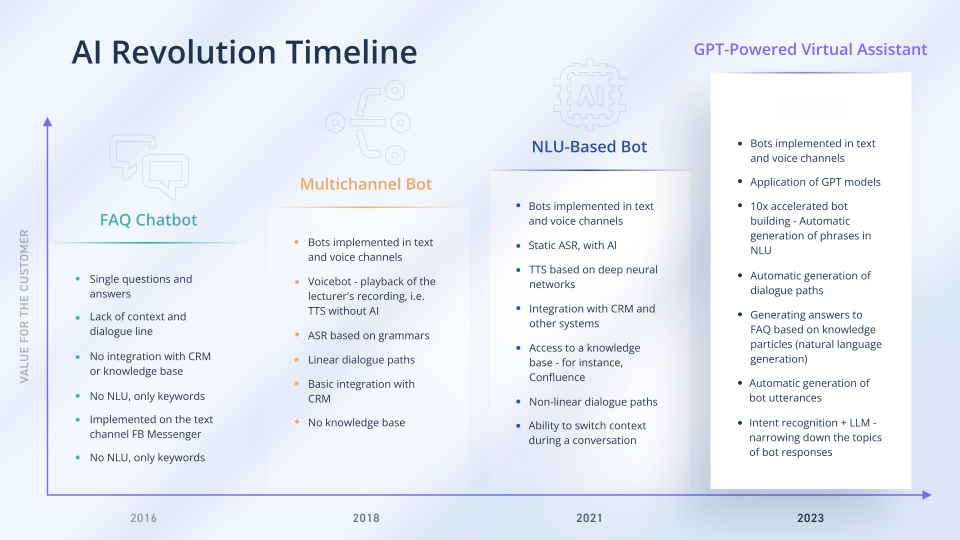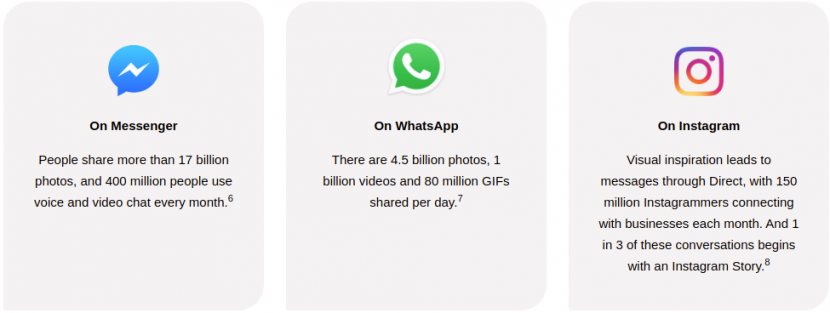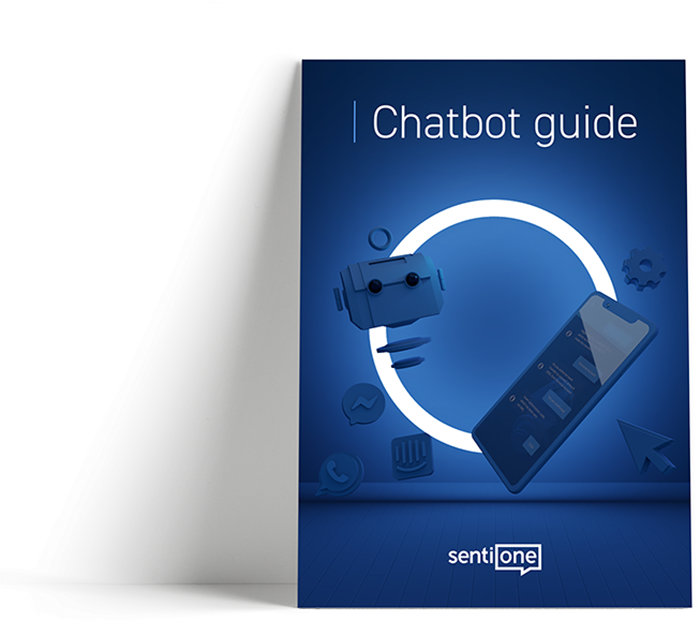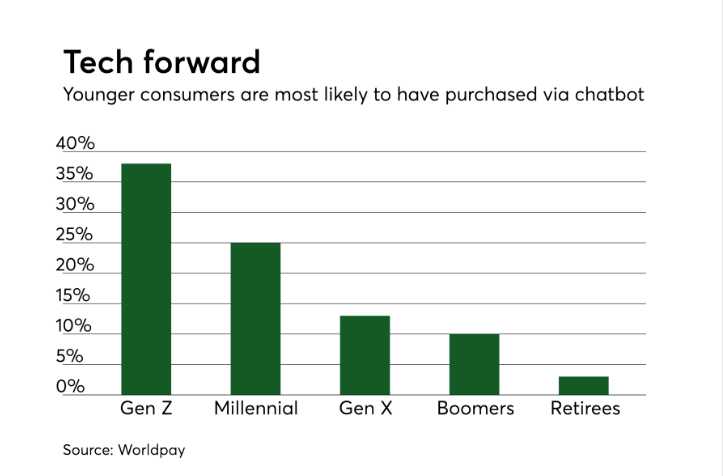Chatbot Guide
Intro
Chatbots and conversational AI are the new black. Well, not that new actually, but the excitement is reaching its peak. Everybody is talking about the absolute necessity of having a chatbot. Sometimes not necessarily knowing what for, why, and how.
Perhaps you’ve found yourself in this pace as well recently. Although, since you are reading these words, the odds are you are not willing to blindly follow the flock. You are clearly looking for some answers. You want to educate yourself before making a strategic decision to invest in conversational AI or even simple bots. Good for you. If you don’t know what exactly chatbots are and how to apply them to your business, read this guide.
What we tried to accomplish here is to explain AI in simple words. So that you can be sure you understand the basics of the CX automation solutions and decide for yourself if it’s worth the hype.

Table of contents
- What is a chatbot?
- What is conversational AI?
- How do chatbots work?
- Conversational AI glossary
- The history of chatbots and conversational AI
-
Why are chatbots important to your business?
- Why do businesses invest in chatbots?
- What benefits can chatbots bring to your business?
-
Most common chatbot solutions
- Basic types of chatbots based on their purpose
- Enterprise chatbot implementations
-
How can you use chatbots in business?
- Most common use cases for chatbots
- With great power comes great responsibility
-
How to make a chatbot?
- What to do when implementing a chatbot?
Chapter 1 What is a chatbot?
A chatbot is a program that understands and responds to user inputs, offering information and assistance or completing tasks using predetermined rules or AI algorithms. They are used in various applications as customer service chatbots, customer support chatbots, and messaging platform bots. A voice bot, on the other hand, is basically a voice-enabled chatbot, an AI-based software that takes voice commands and replies by voice.
There are many different types of chatbots, depending on their purpose, communication channels, the level of advancement. For the most part, they are able to lead a conversation as per designed dialog flow to achieve set objectives like helping in day-to-day chores, answering simple questions (based on the internet research), collecting information, and many more.
Explain Like I’m 5: What is a chatbot?
“Chatbot is a computer program that replaces a human being in selected activities. Bots can be used, for example, to automate customer service processes. Thanks to automatic agents, customers can settle their affairs easier and faster, and companies can save time and costs redirecting people to more creative activities.”
Piotr Kempa, Bot Technology Expert, Founder @Primebot
Subscribe for more news from the world of chatbots
Get a monthly newsletter with AI applications in business
Chapter 2 What is conversational AI?
Conversational AI is a type of artificial intelligence (AI) that can simulate human conversation. It is made possible by natural language processing (NLP), a field of AI that allows computers to understand and process human language. NLP is used to analyse the meaning of text and speech, and to generate responses that are appropriate and relevant to the conversation.
Generative AI systems are designed to create. The output can include images, videos, text, and much more. ChatGPT is a generative AI system that uses a large language model (LLM) to respond to questions using natural language that humans can understand. It acquires the data for its responses through training using massive amounts of text data. As data is processed the system develops associations between words, an AI-based neural network. This massive dataset of information enables ChatGPT to offer pretty sensible answers to virtually anything you might ask. When you provide a prompt, ChatGPT reads, summarises, and translates text by predicting appropriate future words in a sentence. ChatGPT selects and sequences words to your original prompt using associations from its neural network. It does not have the faculties to understand the meaning of the words provided – that’s up to the reader. Nonetheless, the accuracy and relevancy of the answers provided can at times be astonishing.
Conversational AI bots are designed in a way to be useful and effective for businesses deploying them: they can connect via API to various communication channels, as well as to company’s CRM, internal tools and database. Thanks to that, they are suitable for business use cases: customer service, sales and internal processes. Conversational AI bots work in a system of tools, systems and infrastructure, while ChatGPT are stand-alone bots that just create beautiful responses. When we compare ChatGPT to conversational AI, it’s this natural language processing (NLP) component that we’re squaring off. ChatGPT is a state-of-the-art solution for generating responses in natural language. But if you extend this comparison to an actual customer support scenario, it’s all those other components of conversational AI platforms that are critical to consider.
Explain Like I’m 5: What is conversational AI?
“Although it has no ears, it can hear what you say; although it has no head (and brain), it understands; although it has no mouth, it can answer your questions. An AI bot is a computer program that can be enclosed in your phone, television, laptop, and even a toy. Some of them, when asked, can answer various questions like when your favorite cartoon is on the TV, when your mum will return from work, or how long it takes a spaceship to go to the Moon.”
Maciej Buś, Customer Experience Expert, CEO @My Customer World
Chapter 3 How do chatbots work?
Chatbots work on the basis of quite complicated algorithms set to find the meaning in a chosen sentence and then classify the intention to calculate the most suitable reply. The main purpose of the software is to relieve customer service agents or sales reps from repetitive labour, therefore chatbots are able to operate independently.
Explain Like I’m 5: How do chatbots work?
“A chatbot is a robot in the computer which you can have a conversation with. People must first teach it what to say and then it can help others in different situations. Thanks to this, you can talk to your computer or phone to report a failure, pay for shopping, or unlock the phone.”
Bartosz Ziółko, PhD, CEO @Techmo
The technology behind bots differs depending on their level and purpose.
- Rule-based chatbots
The most simple chatbots work as — let’s say — interactive surveys. The system is programmed to push set phrases and give possible replies in a form of buttons within the chat. Choosing a specified reply triggers one of a few dialog directions or specified actions. - Conversational AI
Using deep learning technology they recognise the meaning of words and phrases and their synonyms, calculate the context and possible answers in a 300-dimensional matrix, and reply accordingly. The trick with these bots is finding a vast enough dataset of natural conversations about the chosen topic or industry to successfully train the system.

Over the last few years a lot has changed when it comes to conversational AI chatbots. Here’s an overview:

Chapter 4 Conversational AI glossary
Every industry has its own buzzwords, three-letter enigmas, ciphers, and terms that need to be decrypted in order to know at least the basics. To lead educated conversation with people who are trying to sell you chatbots, make sure you know and understand these phrases.
Artificial Intelligence
A machine simulation of human thinking processes, especially learning, information research and acquisition, and logical reasoning.
ASR
Automated Speech Recognition, a technology used in voice-activated robotic systems allowing to recognise spoken language and translating it to text.
Chatbot
A software able to independently conduct a conversation in a given subject.
Voice bot
A software solution that lets people receive answers to their questions through spoken commands
Customer Service Automation
The technology used to optimise time and costs of customer care processes.
Dialog Flow
All the possible paths that a conversation between a chatbot and a customer can take, including both customer’s statements and bot’s replies.
Intention Recognition
The process of finding the meaning of separate words and phrases in the context of a given dialog and possible processes serviced by a chatbot.
Machine Learning
An artificial intelligence technique based on certain patterns and statistical models, used to create a given analytical model that eventually leads to a computer performing an independent action.
TTS
Text-to-speech, speech synthesis, software designed to artificially emit sound in a form of human-like spoken language.
Virtual Assistant
Automated Personal Assistant, Intelligent Virtual Assistant (IVA), Intelligent Personal Assistant (IPA), a use of AI designed to relieve humans of certain processes and activities; the most known home assistants are Siri and Alexa, but in customer service industry a term referred to any chatbot working in the customer support field.
Bot design
The creative part of chatbot creation that includes composing conversation flows and writing bot responses.
Bot building
The technical part of chatbot creation that includes programming the flows and connecting bots to APIs and databases.
Natural Language Processing (NLP)
A subset of Artificial Intelligence that combines linguistics, computer science, and analysis, enabling machines to interpret speech and text and provide contextually appropriate replies.
Natural Language Understanding (NLU)
A subset of NLP that focuses on extracting context and meaning from natural language inputs. Essentially, it refers to the process through which a computer comprehends the input provided by a user.
Conversational AI
A technology that enables machines to understand, interpret, and respond to human input in a conversational manner by applying Machine Learning and NLP algorithms.
Generative AI
A subset of artificial intelligence that focuses on creating and generating new content.
Large Language Model
An advanced artificial intelligence technology designed to effectively comprehend and analyse human language, trained on large quantities of unlabelled text.
Chapter 5 The history of chatbots and conversational AI
The idea of cognitive machines is about a few decades old. It all started with Alan Turing and his “Imitation Game” which was a mathematical concept designed to create an algorithm clever enough to trick people so that they wouldn’t know if they’re talking to a human or a machine.
Then a few “chatterbots” were developed.
- The first ever chatbot was ELIZA — an algorithm, developed by Joseph Weizenbaum at MIT in 1966, able to pick up words from sentences and put it in context to generate an answer. She wasn’t as intelligent as mechanised but still, passed the Turing test.
- Than there was PARRY, which was based pretty much on the same idea as the previous bot with a few additional traits.
- JABBERWACKY, the chatbot programmed by a British engineer Rollo Carpenter, was what today we would call a beta version of Siri, as it was mostly designed for entertainment and companionship purposes.
- Dr. Sbaitso — imagine a psychologist in your 1992 PC with MS DOS. Yup, that’s right.
- A.L.I.C.E. — “Artificial Linguistic Internet Computer Entity” a natural language processing bot with surprisingly clever name.
- SMARTERCHILD — as we entered the new century, the 2001 brought us a software used mostly in SMS networks for personalised messages.
- WATSON — in 2006 IBM released the first version of their AI system based on simple question-answering engine able to search the internet, which then entered the “Jeopardy!” television show and competed against two human contestants. And won.
- And with no further ado, in 2010 we met Siri.
- Ok, GOOGLE, NOW tell me what happened in 2012.
- In 2015 Amazon introduced Alexa, which is hidden in the Amazon Echo device, able to hear and process natural human language like no other.
- The same year Microsoft launched their first intelligent assistant — Cortana.
- 2016 is definitely a huge game-changer for the chatbot industry as Facebook released their chatbot platform for the Messenger app. Ever since then it is much easier to build even a simple chatbot for your business.
- In the last few years we could also observe a couple of quite intelligent robotic solutions such as TAY, HAL 9000 or Sophia.
As you can see, the chatbot and AI industry is gaining its momentum. Just a few years back, NLU chatbots were barely ever used in business, as both clients and businesses kept their distance having most of their projects still in a proof of concept stage. However, the development and raising popularity of home AI assistants such as Siri, Alexa, or Cortana let us believe in the technology more and opened the door to using conversational bots more. Today most big companies have chatbots as customer communication agents and the audience is starting to trust them more. Unsurprisingly, the younger generations are more used to AI in their lives so the fast development of this technology is inevitable.
Chapter 6 Why are chatbots important to your business?
Chatbots have officially came out of the academic world of experiments and the investigation stage. They became applicable in business and our day to day lives in one form or another.
Why do businesses invest in chatbots?
Let the numbers speak for themselves.
- There are 2 billion messages sent between customers and companies every month.
- 51% of surveyed people say messaging has already replaced other forms of communication with brands.
- 91% of respondents claim to be more likely to purchase if carefully and personally led through the process.

What benefits can chatbots bring to your business?
There’s much value in processes automation. What can you get thanks to chatbots?
- Gain competitive advantage – note that it’s probably the last call to think of chatbots as innovation. In the nearest future they will become a norm.
- Save time and money – processes automation helps cut costs.
- Provide 24/7 support – reduce the waiting time and your customers will love you to the moon and back!
- Dazzle the customers – exceed their expectations using chatbots in creative ways.
Chatbots are important to your business because they’re the future of business in general. Everyone’s quoting the Oracle’s study which says that 80% of companies are willing to invest in AI by 2020. And that number — however incredible — is probably true. The one thing is that it shows the will, not the deed so keep calm and investigate your business case to apply the best form of AI to your business.
If you’d like to learn more about how chatbots can change the game in your business, check out our recent article about maximising chatbot ROI.
Chapter 7 Most common chatbot solutions
The state of the art in chatbot business changes rapidly. What was just fine last year may seem a bit outdated to your clients today. So whatever you do, make sure you keep track of all the changes in the field.
There are many different types of chatbots and many applications for them depending on your industry, business goals, and — of course — budget.
Basic types of chatbots based on their purpose
- Sales chatbots — helping with lead tracking and classification,
- Customer service chatbots — automatic assistants able to complete simple repetitive tasks in the customer support workflow,
- Marketing chatbots — working mostly on social media as channels for leading contests and content distribution,
- Entertainment chatbots — might be included as part of marketing chatbots but used mostly to amuse audiences.
Enterprise chatbot implementations
Advanced chatbot solutions implemented at the biggest companies with the most complex processes need a custom approach. The AIaaS (AI as a Service) companies provide such solutions.
Customer service chatbots are already a common practice in big companies from industries like: insurance, banking, vindication, outsource call centre services, etc. The advanced process crafting requires flexibility and multiple application possibilities so these implementations are usually more costly. However, the ROI is incomparable.
A voicebot needs only 5 minutes to complete the same amount of conversations a human agent can in 38 hours!
Chapter 8 How can you use chatbots in business?
Possible roles for chatbots in your business are as numerous as your needs. Customer service metrics and KPIs you can improve with the help of AI and the number of companies going into that business lead to the simple conclusion that the investment simply pays off.
Most common use cases for chatbots
- Information-oriented chatbots: answering FAQ
- Task-oriented chatbots (bank transfers, data verification, debt collection, appointment reminders)
- Guiding users through simple processes (filling out forms, etc)
- Call handoff to the right human agent
- Gathering sensitive user data
Your chatbots can do all of the above and so much more. People are getting more and more creative with unconventional AI solutions. There are already first shops with all artificial assistants, content creating AI writers, etc.
With great power comes great responsibility
The spread of chatbots helps a lot of businesses, but doesn’t come without a bias. Hollywood has been feeding us more or less fortunate stories about AI for decades. There is a lot of misrepresentation in how movie-makers understand robots which has become a status quo when it comes to this topic.
Today’s companies are facing the challenge of introducing AI solutions that also adhere to laws and ethics. Data security, GDPR, unconscious bias, labour laws, or even environmental issues connected to machine learning – are only some of those problems.
So as long as we want to pay attention to them, we can do good with AI. Conversational AI is applied in many cases that we probably didn’t think of before, like helping the elderly or support healthcare institutions during a global pandemic.
There are also a lot of AI-related projects that help humankind, like crafting algorithms that spot human trafficking and other malicious behaviour on the web. This is what people do pro bono. And if you ever find yourself afraid of chatbots, remember there are still people behind the software.
Chapter 9 How to make a chatbot?
Getting started with chatbots and the AI technology may seem tricky but in fact it doesn’t really have to be that complicated. And if you’re using the right bot building platform (with low-code/no-code capabilities) most of the times you wouldn’t even need any special tech skills.
No matter if you need a simple Facebook chatbot or a complex solution spanning a few departments – make sure you do the proper research first.
First of all, read our best practices of how to kick off the bot project. Think of it as any project and follow these simple steps:
What to do when implementing a chatbot?
- Define your business needs and pain points
- Make objectives and KPIs
- Choose chatbot type
- Choose communication channels
- Create your bot’s personality and design a dialog flow
- Train your bot
- Create a demo or PoC project
- Increase the scope of chatbot’s work (e.g. with multilingual chatbots)
- Measure and report
- Optimise
If you’ve read this far, you should already know there are many different types of chatbots, communication channels, use cases and benefits that come with the whole conversational AI. We hope this text made the whole world of AI more simple to you but if there are still some things that you’d like to discuss, ask away. We have truly amazing NLU engineers on board who really know their stuff so we will provide you with all the answers you need.


